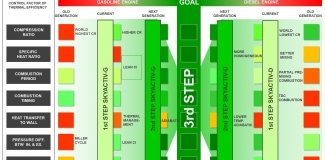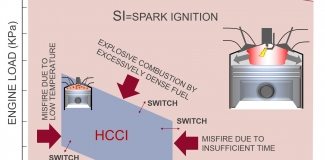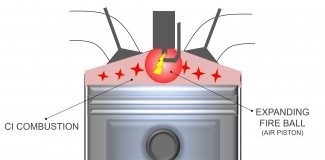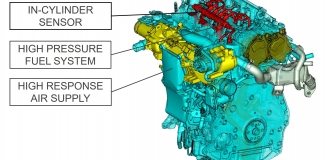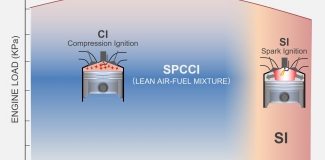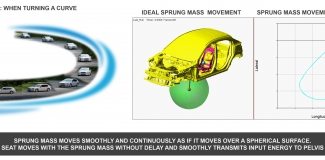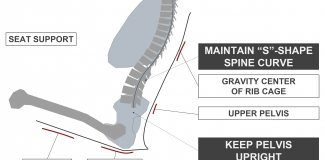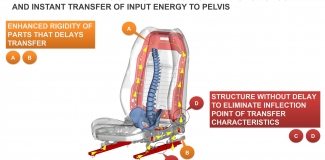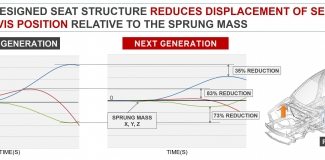News Releases
SKYACTIV-X NEXT-GENERATION GASOLINE ENGINE
Featuring Spark-Controlled Compression Ignition, a never-before-seen combustion method, Mazda’s SKYACTIV-X engine represents the second step in Mazda’s quest to develop a gasoline engine with the ideal internal combustion mechanism.
Developing compression ignition for gasoline engines has long been a goal of engineers. In the SKYACTIV-X, spark plug ignition is used to control compression ignition, resulting in dramatic improvements across a range of important performance indicators.
The SKYACTIV-X is a groundbreaking new engine exclusive to Mazda in which the benefits of a spark-ignition gasoline engine—expansiveness at high rpms and cleaner exhaust emissions—have been combined with those of a compression-ignition diesel engine—superior initial response and fuel economy—to produce a crossover engine that delivers the best of both worlds. Coming after Mazda’s SKYACTIV-G gasoline engine and SKYACTIV-D diesel engine, this third SKYACTIV engine has been given the new name of “X” in recognition of this dual role.
At Mazda, we believe that there is still ample room for further evolution of the internal combustion engine and that this technology has the potential to contribute in a major way to conservation of our global environment. Based on Mazda’s corporate vision of protecting our beautiful planet while enriching people’s lives through the “joy of driving,” we plan to continue on our ceaseless quest to develop the ideal combustion engine.
1. AIMS AND CONCEPT OF THE TECHNOLOGY
[1] ADVANTAGES OF LEAN BURN, AND ISSUES ASSOCIATED WITH IT
As we have moved along the road map shown above, we have undertaken a fundamental reexamination of the nature of combustion, with the aim of making some major improvements in the efficiency of the internal combustion process.
In the SKYACTIV-G, combustion efficiency is boosted by raising the compression ratio, while cooling losses from the zone of the heat transfer to the chamber wall are reduced through control of cooling water temperatures. Pumping losses and mechanical resistance are reduced through use of the Miller cycle.
In the SKYACTIV-X, the latest SKYACTIV engine, we have worked to boost the air-fuel ratio. In order to do this, we had to enable lean burn, in which larger quantities of air are combusted. The ideal (stoichiometric) air-fuel ratio is 14.7:1 Creating a higher air-to-fuel ratio by more than doubling the amount of air raises the specific heat ratio and lowers the combustion gas temperature. This, in turn, reduces cooling losses. Meanwhile, a design that introduces larger amounts of air reduces the losses from throttle closure, resulting in improved fuel economy.
However, the problem is that if this kind of lean mixture of air and gasoline is burned using the flame propagation-based combustion which occurs when a spark plug is used, combustion tends to become unstable. To overcome this problem, compression combustion in high-temperature, high-pressure conditions must be employed. This means that such an engine will need to adopt the compression ignition used by diesel engines. In developing the SKYACTIV-X, we have therefore improved the seven factors which need to be controlled for compression ignition of a lean air-fuel mixture. These include the compression ratio (which needs to be raised in order to realize the required high-temperature, high-pressure conditions), combustion timing near top dead center (which is found in compression ignition), and a combustion period in which all the fuel burns simultaneously.
[2] ISSUES ASSOCIATED WITH HOMOGENOUS CHARGE COMPRESSION IGNITION
One concept underpinning compression ignition in gasoline engines is homogenous charge compression ignition (HCCI). When a spark plug is used for ignition, the combustion has to spread out from the initial spark, resulting in a slower combustion speed. If, in addition to this, a leaner air-fuel mixture with more air is used, the flames created by the spark plug will fail to spread throughout the combustion chamber. With compression ignition, however, all fuel in the combustion chamber combusts simultaneously, resulting in a far higher combustion speed which, in turn, means that a leaner air-fuel mixture can be burned.
However, HCCI has not yet reached the point where it can be used in commercial applications because it is only used at low revolutions per minute and engine load ranges, and even these ranges are apt to change depending on driving conditions. Furthermore, the very limited range across which HCCI can take place makes it difficult to achieve stable switching between spark ignition and compression ignition.
Until now, overcoming these issues had required a major increase in the compression ratio, a more complex structure and the addition of high-precision controls.
[3] SPARK-CONTROLLED COMPRESSION IGNITION: THE BREAKTHROUGH THAT HAS MADE SKYACTIV-X POSSIBLE
“Compression ignition doesn’t require a spark plug, but a spark plug will still be needed in the rpm and load ranges where compression ignition cannot take place. Unfortunately, switching between these two modes is extremely difficult.” This is the “received wisdom” about HCCI, setting out the main issue which has prevented HCCI technology from being fully commercialized.
Mazda’s breakthrough has been achieved by questioning the conventional idea that no spark plug is needed for compression ignition and suggesting a different approach instead: “If switching between different combustion modes is difficult, do we really need to switch in the first place?” This concept is the basis of Spark-Controlled Compression Ignition (SPCCI), Mazda’s unique combustion method.
Using SPCCI means that the range where compression ignition can take place (in terms of engine load and rpm) now covers the whole combustion range. That is to say, the potential application of compression ignition has now dramatically expanded, allowing this technology to be used in almost all driving conditions. In other words, because a spark plug is now being used at all times, the engine can switch seamlessly between combustion using compression ignition and combustion using spark ignition.
2. KEY TECHNOLOGICAL FEATURES OF SPCCI
Although SPCCI is an entirely new combustion method, it is based on two existing functions—ignition and injection—which Mazda has further refined and meticulously recombined. To do this, Mazda has further developed several elementary technologies—a new piston head design and super-high-pressure fuel injection system to support compression ignition, and a high-response air supply which can deliver larger amounts of air—and combined these with an in-cylinder sensor which serves to control the entire engine. Compared with the complicated structures that were previously required in order to utilize the HCCI concept, the hardware for SPCCI is simple and lean, with no unnecessary complexity.
[1] USING COMPRESSION EFFECTS CREATED BY FLAME PROPAGATION.
The SPCCI mechanism can be summarized as a system in which the compression effect of spark-ignited localized combustion is used to achieve the required pressure and temperature to bring about compression ignition.
In other words, the geometric compression ratio is raised to the point where the air-fuel mixture is on the verge of igniting (due to compression) at top dead center. At this point, an expanding fireball created by spark ignition provides the final push that causes the whole mixture to combust. The timing and amount of pressure required are in a continual state of flux depending on constantly-changing driving conditions. The SPCCI system is able to control the spark plug ignition timing, meaning that pressure and temperature within the combustion chamber can be optimized at all times. Because a spark plug is used all the time, the system is able to switch seamlessly to spark ignition combustion in rpm or load ranges where compression ignition would be difficult. In this way, the system ensures that the compression ratio is never raised too high, while enabling a simple design which does not require complicated features such as variable valve timing or a variable compression ratio.
[2] FUEL DENSITY DISTRIBUTION WITHIN THE AIR-FUEL MIXTURE
The SKYACTIV-X controls the distribution of the air-fuel mixture in order to enable lean burn using the SPCCI mechanism. First, a lean air-fuel mixture for compression ignition is distributed throughout the combustion chamber. Next, precision fuel injection and swirl is used to create a zone of richer air-fuel mixture—rich enough to be ignited with a spark and to minimize nitrous oxide production—around the spark plug. Using these techniques, SPCCI ensures stable combustion.
[3] CONTROLLING THE AIR-FUEL MIXTURE TO PREVENT ABNORMAL COMBUSTION
1) Split fuel injection
In order to prevent the abnormal combustion which can occur when rich air-fuel mixtures are compressed for long periods of time—a longstanding issue for HCCI—SPCCI adopts a split fuel injection system, in which part of the fuel is injected during the air intake process and part is injected during the compression process. First, the low-density lean mixture for the lean burn is injected during the air intake process; then, during the compression stroke, a separate injection creates the richer air-fuel mixture that is ignited around the spark plug. This not only distributes the density of the air-fuel mixture so as to allow SPCCI to take place but also minimizes the time lag until the air-fuel mixture ignites under compression, effectively controlling abnormal combustion.
2) Super-high-pressure fuel injection system
To minimize compression time and make compression ignition as efficient as possible, the fuel must be vaporized and atomized very quickly and then immediately dispersed around the whole of the cylinder. The SKYACTIV-X therefore features a system capable of injecting fuel at super-high pressure from a multi-hole fuel injector positioned in the center of the combustion chamber. This causes the fuel to be vaporized and atomized instantly, while powerful turbulence is simultaneously created, greatly improving ignition stability and combustion speed. Super-high-pressure fuel injection enables SPCCI, which suppresses abnormal combustion even at full throttle/low rpms where traditional gasoline engines have to retard ignition and thus sacrifice efficiency and power.
3) Adoption of the in-cylinder pressure sensor
In addition to the abovementioned technologies for preventing abnormal combustion, an in-cylinder sensor has also been introduced as a monitoring control; by continually observing whether the above controls are bringing about proper combustion and compensating in real time for any deviations from intended outcomes, it ensures continuously optimized combustion.
Based on the techniques set out above, SPCCI has expanded the zone of compression ignition right into the full throttle range, and enables smooth switching between SPCCI combustion and spark ignition combustion.
This new combustion method does not merely use spark ignition to assist compression ignition, but delivers an all-encompassing combustion control system which includes control of in-cylinder temperature and pressure and control of the fuel injection’s air-fuel mixture distribution density and exhaust gas recirculation (EGR).
3. VALUE PROVIDED BY SKYACTIV-X
[1] DRAMATICALLY IMPROVED OUTPUT PERFORMANCE AND RESPONSIVENESS
With an engine displacement of 2.0L, the SKYACTIV-X delivers at least 10 percent more torque than the current SKYACTIV-G, and up to 30 percent more at certain rpms (data as of August 2017, during the development process). In addition, because the throttle valve is open most of the time, it exhibits the superior initial acceleration response found in diesel engines which do not have a throttle valve. On the other hand, the SKYACTIV-X spins up into the higher rpm ranges as smoothly and easily as a typical gasoline engine.
[2] DRAMATIC IMPROVEMENT IN FUEL ECONOMY
In a vehicle with a 2.0L engine displacement, the SKYACTIV-X delivers a 20 percent improvement in fuel economy compared to the SKYACTIV-G, a dramatic increase. Furthermore, in areas where low vehicle speeds are used frequently, fuel economy can be improved by up to 30 percent thanks to the use of super lean combustion. Compared to the MZR engine of 2008, fuel economy is improved a dramatic 35-40 percent, and SKYACTIV-X even equals or exceeds Mazda’s latest diesel engine, SKYACTIV-D, in fuel efficiency. With improvements being especially great in the light engine load range, this engine challenges the commonly-held belief that a large engine displacement means poor fuel economy.
The range where the engine is able to deliver excellent fuel economy has been dramatically expanded with the use of the SKYACTIV-X, meaning that this system is able to deliver lower fuel consumption than ever before in a whole range of driving scenarios, including city driving, long-distance driving on expressways and more.
Unique to Mazda, the SKYACTIV-X is a new kind of combustion engine that combines the advantages of gasoline and diesel engines to achieve outstanding environmental performance and uncompromised power and acceleration performance. This revolutionary technology represents the start of an exciting new stage in our quest to develop the ideal internal combustion engine. Fully supporting the Jinba-ittai driving experience Mazda aims to provide, SKYACTIV-X was developed in consideration of our planet and all who live here.
NEXT-GENERATION SKYACTIV-VEHICLE ARCHITECTURE
With our revolutionary SKYACTIV technologies, redesigned from scratch to provide breakthrough performance, Mazda has consistently aimed to provide the joy of Jinba-ittai driving. With Jinba-ittai, the car responds almost as though it were an extension of the driver’s body, enhancing safety and peace of mind. In our effort to create such cars, we have focused on a human-centered development process.
Now we have developed our next-generation SKYACTIV-Vehicle Architecture in which the basic functions of our SKYACTIV technology series have been fine-tuned to ensure that occupants can leverage their natural ability to maintain their balance while the car is moving. More than on individual components systems such as the seats, the body, the chassis, the tires and so on, in development we have focused on vehicle-total coordination, reallocating functions and creating an architecture that works together as a coordinated whole.
Making full use of inherent human abilities has allowed us to go beyond the traditional concept of a platform for more intimate communication between car and driver. Mazda has taken the joy of driving to the next stage, for the ultimate in Jinba-ittai driving in which the driver is barely aware of the car itself.
1. AIMS AND CONCEPTS OF THE TECHNOLOGY
[1] DEVELOPING THE “IDEAL STATE” BY ANALYZING HUMAN WALKING PATTERNS
When a person walks, the body creates an axis of forward movement that serves as a baseline for maintaining balance, making use of the flexibility of the spinal column. Mazda calls this line the “progression axis.” It forms a starting point for maintaining a state of dynamic balance in which the pelvis and upper body move in opposite directions, with muscular exertion and small adjustments of the posture being used to control the body’s center of gravity and suppress the motion of the head.
This means that when the walker changes direction or encounters a change in level, the body can continue moving smoothly and continuously in the intended direction without the progression axis being thrown off-course. However, people are not conscious of this. This balance ability, an inherent advanced human ability, is a skill people use unconsciously.
To use this balance ability, the body needs to maintain a posture in which the pelvis is upright and the spine forms an “S,” while the reaction force from the ground is transferred to the pelvis via the lower legs, allowing the pelvis to move smoothly in a systematic and continuous pattern. This pattern of movement in a person who is walking represents the ideal state of motion, allowing the walker to move in comfort and with minimal fatigue, while being ready to respond instantly to any sudden disturbances in his or her environment.
[2] THE IDEAL STATE FOR VEHICLE OCCUPANTS
Mazda has conducted research into this ideal state of motion, with the aim of designing vehicles which allow occupants to use their natural and instinctive balance ability in the same way they do when walking.
In other words, the seats in such a car allow occupants to sit with the pelvis supporting the spinal column in an S-shape, while the reaction force from the ground is smoothly transferred through the car body rather than through the person’s legs for smooth, continuous movement of the pelvis. In addition to optimizing each component and function, SKYACTIV-Vehicle Architecture has enhanced the connectedness of functions in various areas including the seats, body, chassis and tires to create a vehicle in which everyone can make use of their natural balance ability at all times for a comfortable, relaxing drive in which the head is stable and occupants can respond immediately to changes in the driving environment.
[3] Key points to ensure occupants can use their balance ability
To ensure that occupants can use their natural balance ability to the full when in a car, the movement of sprung mass is a key point. When, for example, a car rounds a curve, the sprung mass must be able to move smoothly and continuously, as though describing the surface of a sphere, while the seats, which are between the sprung mass and the occupant’s pelvis, move in conjunction with the sprung mass without a delay, so that input energy is transmitted smoothly to the occupant’s pelvis.
To develop sprung mass capable of this kind of smooth, continuous movement, Mazda has focused on the following three points.
1) Ensure energy is transferred from unsprung to sprung mass in smooth waveforms
2) Align the direction of forces
3) Reduce rigidity variations between diagonally opposing corners
Achieving these three aims ensures that diagonally opposing corners move together without a delay as they send and receive energy.
2. KEY TECHNOLOGIES
[1] SEATS: MOVING TOGETHER WITH THE SPRUNG MASS
In SKYACTIV-Vehicle Architecture, the latest insights obtained from research into human biology have been incorporated into the design of the seats, ensuring that occupants are able to make full use of their balance ability when in the car by ensuring that the occupant’s pelvis is supported so as to maintain the spine’s S-shaped curve.
Specifically, the technology supports the upper pelvis to ensure that the entire pelvis is positioned correctly. Meanwhile, the shape and firmness of the seat envelop the gravity center of the rib cage (corresponding to the upper section of the S-shaped curve of the spine), helping to keep the spinal column in this position. In addition, the shape and rigidity of the cushioning provide good support for the thigh bones, creating a structure which allows the user to adjust the angle of the thighs independently, to ensure that the seat can take on and adapt to individual differences in physique.
Next, we have increased the rigidity of individual components of the seats and of the attachment points that transfer forces from the vehicle body. This eliminates any lag between the movements of the sprung mass and those of the seats, ensuring that input energy is transferred smoothly to the occupant’s pelvis. Finally, we have also made the seats’ internal structure more rigid to ensure that the load is transmitted more directly from the sprung mass to the occupant’s body.
These changes minimize the movement of the seat relative to the sprung mass; the seat moves together with the sprung mass with no delay and forces are transmitted to the pelvis smoothly.
[2] BODY: TRANSMITTING FORCE WITHOUT DELAY
Keeping in mind the ideal path for transmitting input energy from the ground to the body, we have taken the basic SKYACTIV-Body model—based on the concept of a “straight and continuous” framework—and fine-tuned it still further. To the ring structures that connect the framework vertically and laterally in the previous body, Mazda has now added front-to-back connections, creating multi-directional ring structures that improve diagonal rigidity. The front cowl side panel, front damper and rear damper attachments and rear door opening have been positioned for maximum effectiveness, based on analysis of the energy path.
As a result of this new multi-directional ring structure, the delay in the transmission of input energy to the diagonals stretching from the front to the rear has been reduced by 30 percent compared to the current body, with forces now transmitted between all four diagonal corners almost instantly.
[3] CHASSIS: SMOOTHING OUT INPUT FORCES FROM THE UNSPRUNG MASS
Input energy from the ground is communicated to the body via the suspension. Traditionally, vehicle architecture has been designed to reduce the magnitude of forces conveyed to the sprung mass. With SKYACTIV-Vehicle Architecture, however, Mazda has added a new concept—smoothing out the forces conveyed to the unsprung mass over the time axis—and has completely redesigned the allocation of functions among the various components based on this.
While the suspension operates in a vertical direction, the suspension arm angle faces downward (in an inverted V shape) at all times, so that the inertial force of the sprung mass pushes the tires down toward the ground. Meanwhile, the use of a spherical bush ensures that the transmission of energy is perfectly aligned with no slippage, making it easier for the attachment of the suspension arm and link to rotate smoothly.
A more efficient functional arrangement has also been adopted for the tires. In a stark departure from our previous approach, which focused on increasing the vertical stiffness of the tires, we have softened the side walls and reduced stiffness. Doing so has allowed us to plan for the adoption of Mazda’s unique vehicle dynamics control technology, G-Vectoring Control,* right from the initial conceptual stage of platform development, resulting in a more effective functional allocation.
As a result, the rubber of the tires is able to exert its vibration absorption and damping effects to the maximum extent. Meanwhile, vehicle load transfer is utilized proactively during steering, meaning that tire force can be exerted without any time lag.
* G-Vectoring Control adjusts engine torque in response to steering input in order to control lateral and longitudinal acceleration (G) forces (controlled separately in traditional vehicle architecture), in a unified way and optimize the vertical loading of each tire to realize smooth and efficient vehicle behavior.
[4] IMPROVED NOISE, VIBRATION AND HARSHNESS (NVH) PERFORMANCE
Creating a quiet interior space is another important factor in ensuring that people can make maximum use of their natural abilities. SKYACTIV-Vehicle Architecture represents a major step forward in NVH performance.
Through research into the human hearing mechanism, we discovered that people experience more discomfort when sounds and vibrations increase suddenly or to a marked extent, and we focused on this in addition to the overall volume under normal conditions. We worked to ensure that noise and vibration from various sources changed more linearly over the time axis, with the aim of creating superior perceived quietness for occupants.
Damping characteristics for vibration energy are important in terms of controlling both the timing at which noise enters and the direction from which it arrives. To ensure effective control over vibration energy entering the body, Mazda has used a new high-efficiency damping structure that includes damping nodes and damping bonds, depending on the characteristics of the points where energy tends to concentrate.
With traditional vehicle architecture, a sudden change in the road surface (from smooth to rough, for example) creates a change in noise levels over and above the actual change in vibration energy conveyed from the road. With Mazda’s new vehicle architecture, by contrast, a change like this is experienced by occupants as a more gradual and linear shift commensurate with the actual degree of change in the surface. The ultimate result is a quieter and more comfortable ride.
At Mazda, we believe that cars can bring joy to our lives.
The Jinba-Ittai driving feel invigorates the minds and bodies of drivers and passengers alike and draws out the natural abilities, giving rise to the “joy of driving” that is our ultimate goal.
Mazda hopes to protect our beautiful planet while enriching people’s lives and society as a whole through cars that offer this unique form of driving pleasure.


